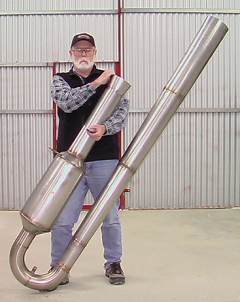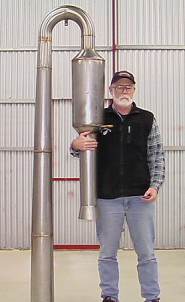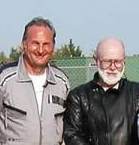Jet engine technologies for interested amateurs
Last Updated: 15 September, 2003
|
15 Sept, 2003: Check out my new BIG Lockwood engine at the page bottom!
Why A Lockwood?
The only "store-bought" parts were the mandrel-drawn U-bend. Unfortunately I couldn't get a 180 degree bend so ended up having to weld two 90 degree bends together. I checked that the inside of the join was smooth and without any roughness so as not to upset the gasflow at this high-velocity point. I built the engine exactly as to Lockwood's own plans -- with the exception of the fuel injector. No fuel injection method is actually shown on the plans but I understand that most builders use a couple of tubes mounted at the widest point of the front cone. These tubes are at 90 degrees to each other (thus forming an 'X') and are slit along their length so that liquid propane is sprayed into the chamber. For my engine I built a single-point, radial spray nozzle that produces a flat, 180 degree spray pattern at the same point (directly in line with the joint between the front cone and the combustion chamber. This nozzle did cause some problems -- but I fixed them fairly easily.
For testing and comparison purposes, I mounted the engine on my gokart.
Mounting the engine horizontally required a bit of smart thinking from the perspective of how to secure it. The Lockwood is an awkward shaped engine and my first attempts at mounting were a dismal failure -- actually resulting in some damage to the engine itself. I had simply welded brackets onto the exhaust cone, intake cone and U-bend. Using these brackets, the engine was bolted to a mounting frame on the kart.
Unfortunately, this method of mounting resulted in a bent engine!
It seems that the engine undergoes significant expansion when running and, since the front and rear ends of the engine were fixed, the exhaust cone crumpled somewhat as it expanded. To get around this problem I ended up building a somewhat elaborate system of mounts and a sliding shaft. This new method works brilliantly, securely holding the engine but allowing for any amount of expansion. You can see from the mark on the shaft (picture right) that the engine actually grows by almost half an inch when it's hot -- no wonder it bent before!
Oops! The Accident One of the nice things about traditional pulsejets is that the intake and exhaust face in opposite directions. This means that if you get a detonation during startup, the huge ball of flame that results is blown out the back of the engine -- away from the operator.
I had planned to use compressed air fed through a small pipe into the engine's intake -- but using this method I had great difficulty in getting the engine to fire. I suspect that my little 7 cfm compressor was having trouble providing enough "puff" to do the job. Deciding that more air was required, I simply pulled out my trusty old leaf-blower, which as it happens has never seen a leaf in its life, and used it as the air-source. On the first day, the engine had started several times but wouldn't keep running. I was feeling quite comfortable about standing slightly to one side of the engine with the blower -- any fireballs were directed well away from me and dissipated quite quickly. The problem arose the following day after I had made some changes to the fuel system and had gotten the thing running quite consistently. I had placed the LPG tank to one side and slightly behind the kart. As I had done the day before (and several times earlier that day), I fired up the leaf-blower and (remembering to stand to one side) directed it at the engine's intake. Whoosh! -- a huge fireball shot out of the engine. Unfortunately, I hadn't noticed that the wind had changed direction -- something which meant that and that fireball was now headed straight for me. Seeing the danger and feeling the heat, I instinctively took a rapid step backwards -- and tripped over the propane tank. In the process of falling, I hit my head against the concrete driveway and saw stars-- don't worry, the driveway is fine, there are no lasting stains. Even my beard and eyebrows are regrowing nicely. This little accident put me out of commission for quite a while -- it's hard to run a loud pulsejet engine when your head aches so bad and I'm only now getting back to speed. Perhaps this is a good time to remind all those who are experimenting with, or who plan to experiment with these engines that you really do have to be careful. Accidents can happen in the blink of an eye.
The Lockwood's Performance
Less impressive is the fuel consumption -- it gulps fuel at a faster rate than my conventional 100lb-thrust engine. A 20lb tank of propane lasts just 4.5 minutes -- producing a specific fuel consumption (SFC) rate of nearly 5lbs/lb/hr. I'm also somewhat disappointed by the range of throttle control available. As soon as I drop the power below about 30lbs-thrust, it starts to get very erratic and will flame out with little provocation.
I'll be addressing both these issues in the near future -- but my thrust figures seem to be very similar to those obtained by Paul Sherman with his Lockwood. I recently came across another home-built Lockwood project page on the Net but the builder says that no thrust measurements for this engine have yet been made. One very interesting thing I noticed immediately about the Lockwood is that it's a lot louder than my 100lbs conventional engine. Maybe it's because it pushes gases out of two holes, and perhaps that conical tailpipe acts as a rather impressive megaphone but it's sure a noisy beast -- even by pulsejet standards.
Riding The Lockwood-powered Kart You'll find pictures of the wild ride here and there's video footage on my CDROM. This month (September 2003) I plan to add some video clips taken from an onboard camera and to measure the top speed of the kart using a GPS unit.
Don't miss that update!
That combustion chamber has a capcity of 18 litres (around 1,100 cubic inches) and it will guzzle nearly 750lbs of fuel per hour!
I won't tell just yet what this engine (and three others the same size) are
going to be used on, but suffice to say that it's a project which has
the endorsement and the interest of none less than the famous
Richard Noble
(that ought to be a good hint :-)
|
|

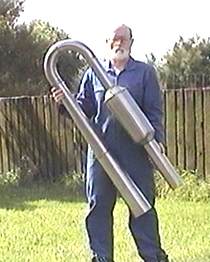 The engine was made from 0.8mm 302 stainless steel sheet, rolled and formed
into the cones and tubes necessary then welded together.
The engine was made from 0.8mm 302 stainless steel sheet, rolled and formed
into the cones and tubes necessary then welded together.
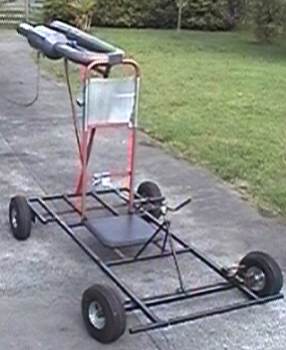
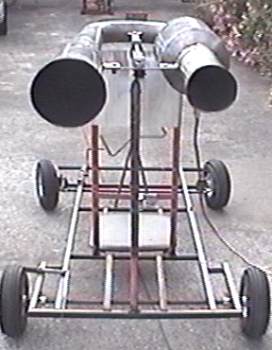
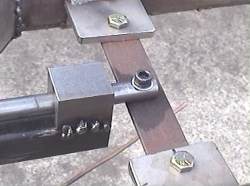
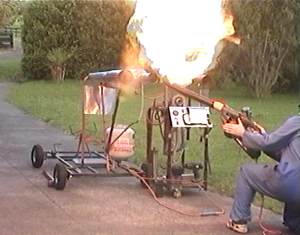 In the case of the Lockwood however, the intake and exhaust both
face in the same direction -- directly towards the guy with the leaf-blower!
In the case of the Lockwood however, the intake and exhaust both
face in the same direction -- directly towards the guy with the leaf-blower!
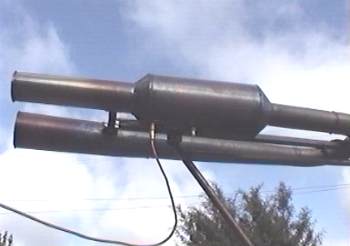 Well my engine produces about 55lbs of thrust -- not too bad really but still
short of the 75lbs Lockwood himself claimed to have obtained.
Well my engine produces about 55lbs of thrust -- not too bad really but still
short of the 75lbs Lockwood himself claimed to have obtained.
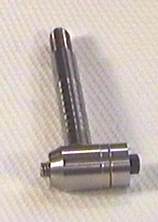 To be fair, it could be that my fuel-injection system might be somewhat to
blame here and I intend to fit the recommended X-pipes as soon as I've
picked up some suitable stainless tubing. It might be that the
small amount of damaged produced by the first engine-mounting system
may have also contributed to the lackluster results I'm seeing.
To be fair, it could be that my fuel-injection system might be somewhat to
blame here and I intend to fit the recommended X-pipes as soon as I've
picked up some suitable stainless tubing. It might be that the
small amount of damaged produced by the first engine-mounting system
may have also contributed to the lackluster results I'm seeing.
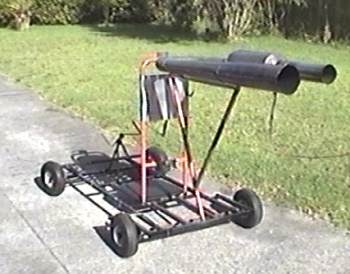 Yes, I've finally found the time to get aboard the kart with this Lockwood
engine running.
Yes, I've finally found the time to get aboard the kart with this Lockwood
engine running.
